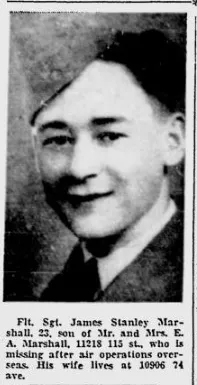Blake, Wilfred Albert (Squadron Leader)
Killed in Action 1943-April-21


Birth Date: 1920
Born:
Parents:
Spouse:
Home: Gloucester, Ontario
Enlistment:
Enlistment Date: unkown date
Service
RAF
Unit
7 (PFF) Sqn- Squadron (RAF)
Per Diem Per Noctem By day and by night
Base
RAF Oakington
Rank
Squadron Leader
Position
Pilot
Service Numbers
40202
Crew or Other Personnel
Stirling R9261
Mission
Stirling Mk. I R9261
Bombing Stettin Germany 1943-April-20 to 1943-April-21
7 (PFF) Sqn (RAF) RAF Oakington
Battle of the Ruhr
339 aircraft - 194 Lancasters, 134 Halifaxes, II Stirlings. 21 aircraft - 13 Lancasters, 7 Halifaxes, 1 Stirling - lost, 6·2 per cent of the force.
This raid, on a target more than 600 miles from England, proved to be the most successful attack beyond the range of Oboe during the Battle of the Ruhr. Visibility was good and the Pathfinder marking was carried out perfectly. 24 fires were still burning when a photographic reconnaissance aircraft flew over Stettin a day and a half later. Approximately 100 acres in the centre of the town were claimed as devas¬tated; much of this area comprised industrial buildings. German reports show that 13 industrial premises and 380 houses were completely destroyed. A large chemical factory was among the places where production was completely halted. 586 people were killed in Stettin.
source: The Bomber Command War Diaries, Martin Middlebrook and Chris Everitt
It all had begun on the evening of April 20, 1943. A major bombing operation was launched from bases in England against numerous German targets. Among the planes taking part in the raid was a Stirling bomber, M for "Mother", of the 7th Squadron Pathfinders. The plane had a mixed crew of men from the British Commonwealth: "¢ Flt. Lt. Charles Woodbine Parish Pilot R.A.F "¢ Pilot Officer E. R. (Bob) Vance Navigator R.C.A.F "¢ Flt. Sgt. J.S. (Jimmy) Marshall Bomb Aimer R.C.A.F. "¢ Flt. Sgt. Louis Krulicki Wireless Operator R.C.A.F. "¢ Sgt. Charles Farley Mid Upper Gunner R.A.F "¢ Sgt. Jack Lees Rear Gunner R.A.F "¢ Sgt. Donald V. Smith Flight Engineer R.C.A.F
Their destination that night was Stettin, and their mission was to locate the target area and mark it with incendiaries as a guide for the rest of their planes. They had an extra crew member that night, Squadron Leader Blake, a Canadian pilot who was new to the squadron and who was to accompany them on an orientation flight.
Their aircraft was damaged by flak on approach to the target and, unable to mark it reliably, they aborted and left the job to a backup plane. Heading back to England, they flew over the Baltic and the relative safety of the water. As they approached Korsor, they had to veer across land to avoid a flak ship in the Belt, but soon found themselves under attack by an ME 110 night fighter. After a burst of cannon fire set their plane afire, the order was given to bail out. Don Smith was the only one who managed to escape from the plane before it crashed into a farmer's field near Kongsmerk Denmark
source: Dave Smith,son of Donald V Smith
Stirling serial: R9261

In June 1944, this Short S.29 Stirling B Mk. IV (Serial No. LK589), coded V3, RAF, was flown across the Atlantic as part of a navigation training exercise and did a tour of bases in Eastern Canada. It is shown here at Malton, Ontario. It was flown back to the UK after a two-week visit.
The Short Stirling was a British four-engined heavy bomber of the Second World War. It has the distinction of being the first four-engined bomber to be introduced into service with the Royal Air Force (RAF).
The Stirling was designed during the late 1930s by Short Brothers to conform with the requirements laid out in Air Ministry Specification B.12/36. Prior to this, the RAF had been primarily interested in developing increasingly capable twin-engined bombers but had been persuaded to investigate a prospective four-engined bomber as a result of promising foreign developments in the field. Out of the submissions made to the specification Supermarine proposed the Type 317, which was viewed as the favourite, whereas Short's submission, named the S.29, was selected as an alternative. When the preferred Type 317 had to be abandoned, the S.29, which later received the name Stirling, proceeded to production. In early 1941 the Stirling entered squadron service. During its use as a bomber pilots praised the type for its ability to out-turn enemy night fighters and its favourable handling characteristics whereas the altitude ceiling was often a subject of criticism. The Stirling had a relatively brief operational career as a bomber before being relegated to second line duties from late 1943. This was due to the increasing availability of the more capable Handley Page Halifax and Avro Lancaster, which took over the strategic bombing of Germany. Decisions by the Air Ministry on certain performance requirements (most significantly to restrict the wingspan of the aircraft to 100 feet) had played a role in limiting the Stirling's performance; the 100ft limit also affected earlier models of the Halifax (MkI & MkII) though the Lancaster never adhered to it.
During its later service, the Stirling was used for mining German ports; new and converted aircraft also flew as glider tugs and supply aircraft during the Allied invasion of Europe during 1944"“1945. In the aftermath of the Second World War, the type was rapidly withdrawn from RAF service, having been replaced in the transport role by the Avro York, a derivative of the Lancaster that had previously displaced it from the bomber role. A handful of ex-military Stirlings were rebuilt for the civil market. Wikipedia


